The AMD Kabini Review: A4-5000 APU Tested
by Jarred Walton on May 23, 2013 12:00 AM ESTKabini Gaming and Battery Life
We've covered the general performance and some synthetic graphics tests. What about actual games? Well, here’s what our (admittedly punishing) 2013 gaming suite looks like on Kabini. These are the "Value" results, as the "Mainstream" and "Enthusiast" settings are unplayable on anything without a dGPU (though those results are available in Mobile Bench if you're interested).
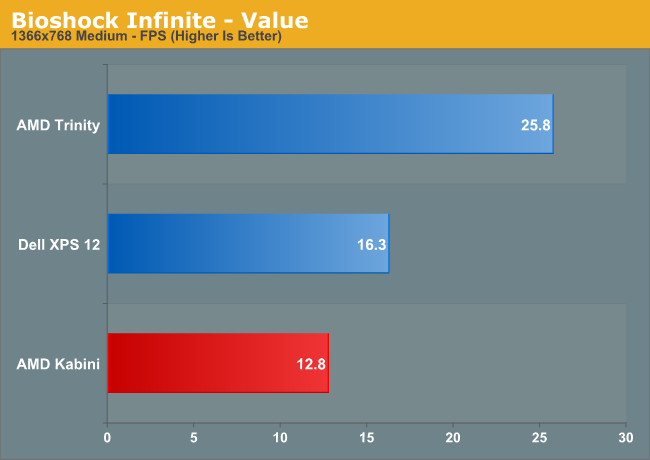

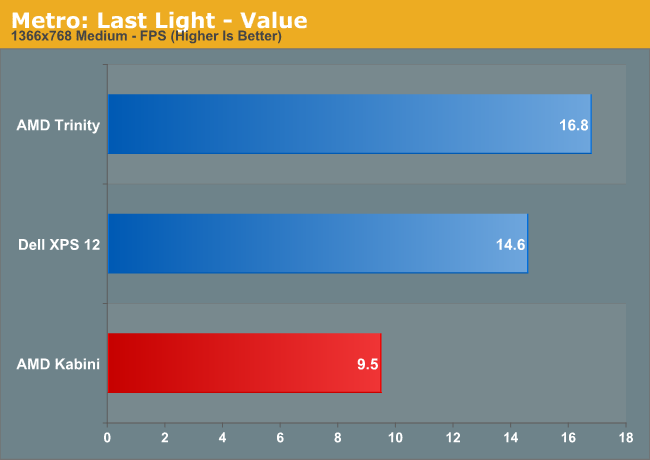
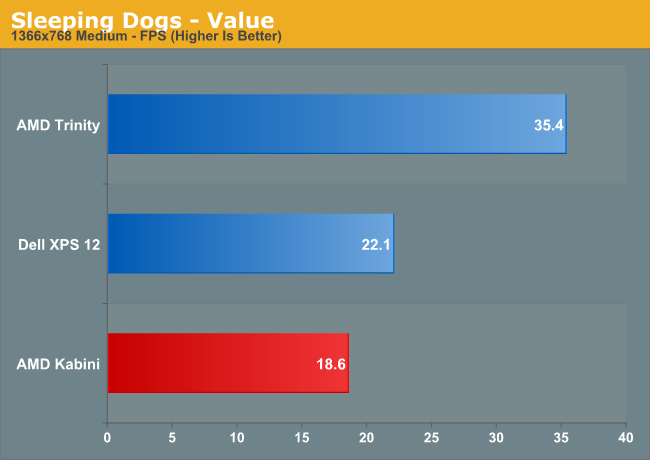
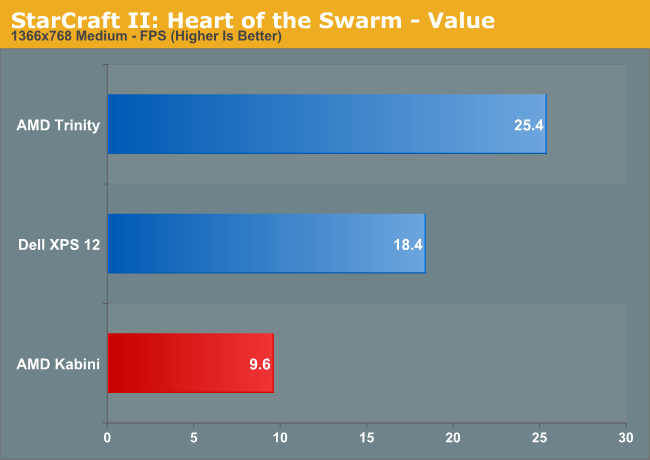
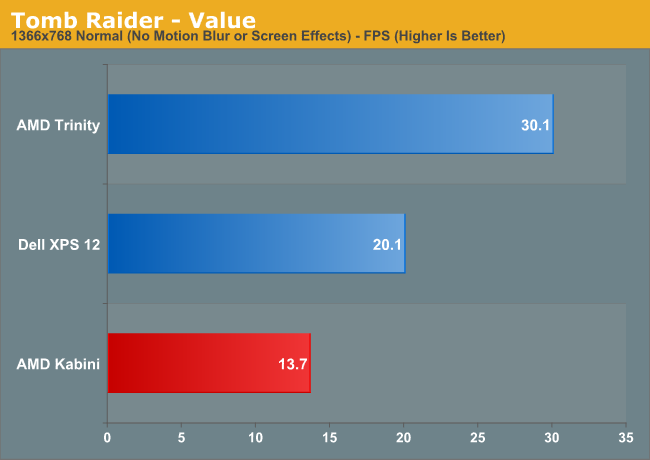
The short summary is that not a single game manages to crest the 30FPS mark, and I even ran additional tests at the minimum quality settings (at 1366x768) to see if I could improve the results. Sadly, I couldn’t, at least not enough to make the games playable; the best I managed was around 25 FPS in Bioshock, Skyrim, and Tomb Raider at minimum detail, and most titles remained in the sub-20 FPS range. Titles that tend to be more taxing on the CPU side of things like StarCraft II are even worse, with frame rates in StarCraft II being half of what IVB ULV gets at our Value (medium quality minus antialiasing) preset.
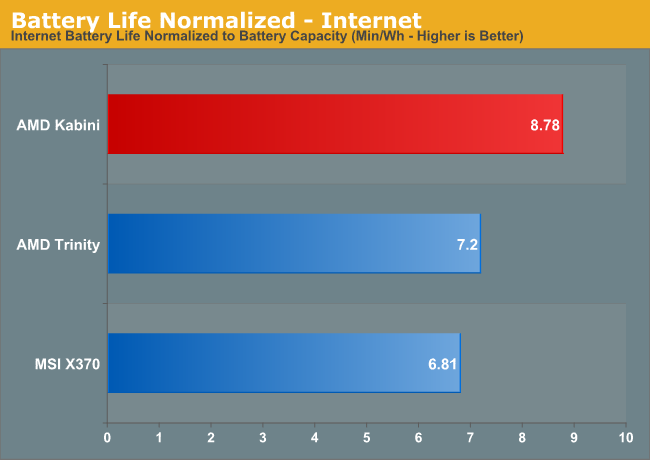
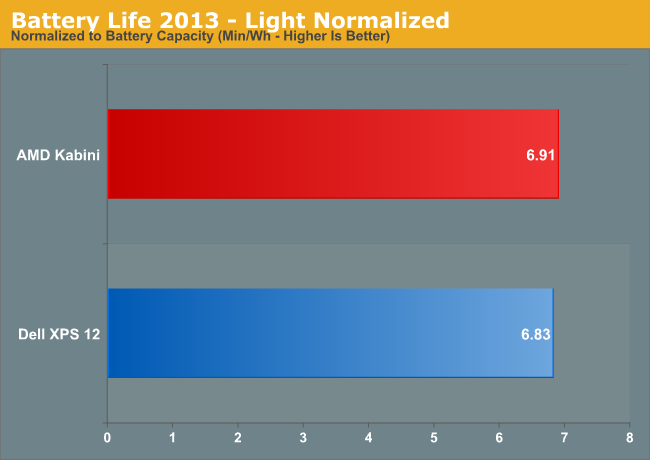
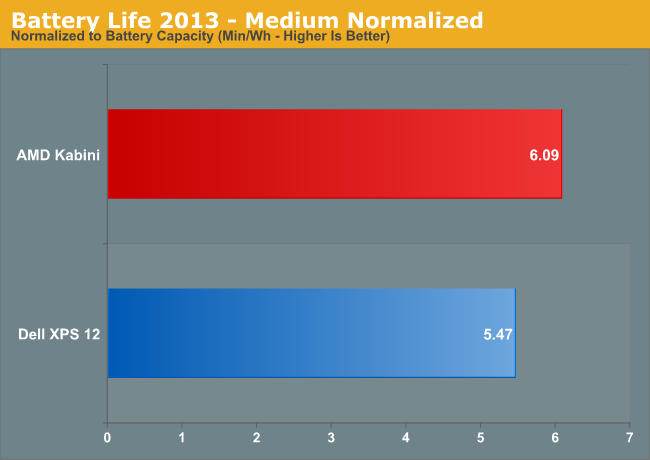
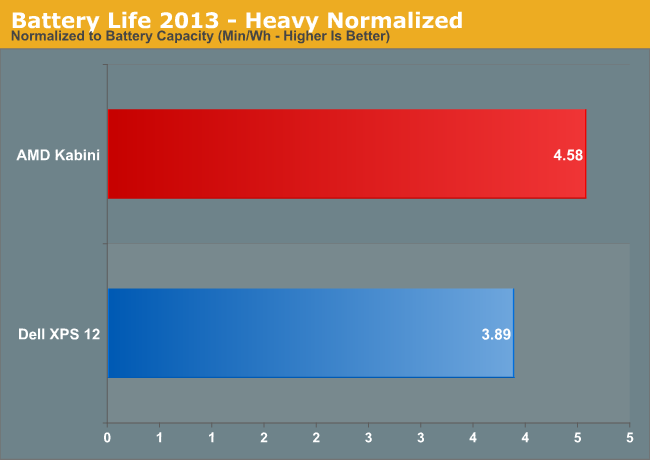
The good news is that not only is Kabini noticeably faster than Brazos, but it’s also mighty frugal when it comes to power use. We don’t have any Brazos laptops handy, so we had to use our older Internet battery life test as a comparison point (100 nits instead of 200 nits); in that test, Kabini topped 6.5 hours with a 45Wh battery. The MSI X370 we’re using as a comparison point did last a bit longer, but it also has a 64Wh battery. In terms of normalized power use, the Kabini laptop ends up being 29% more efficient, and that’s with a 14” AHVA 1080p panel going up against a 13.3” TN 768p display. We’re not quite able to compare apples to apples, but Kabini definitely looks like a good improvement over Brazos in power use.
The power story is even better when we look at ULV Ivy Bridge and standard Trinity APUs. Using our new battery life tests, which push the hardware a lot harder than our previous tests, Kabini delivers normalized battery life that’s at least equal to IVB ULV (our “Light” test), and in the more taxing Medium and Heavy tests Kabini beats ULV by 11% and 18%, respectively. Of course the IVB ULV system is still faster, and it’s also likely to cost twice what we expect Kabini laptops to sell for, but lower cost Celeron and Pentium ULV parts shouldn't be all that different. Also of note is that we don’t know yet how Haswell will fare in these same tests, but that’s an area Intel seems to be focusing on for their next CPU; that’s a story for next month….










130 Comments
View All Comments
Kevin G - Thursday, May 23, 2013 - link
Those aren't real benchmarks, just estimates that are based upon improvements from an anonymous source.TerdFerguson - Thursday, May 23, 2013 - link
It should be criminal to market any of these chips as "Elite Performance" platforms. The words elite and performance have pretty well understood meanings, which nothing AMD is offering stand up to. If I'm shopping for a new computer and it is advertised as an elite performance platform, I'm going to expect it to run AAA games at elite settings.AMD is distancing themselves from my wallet a little more every day, thanks to weak products, weak initiatives, hype and terribly dishonest marketing.
Finally - Thursday, May 23, 2013 - link
I want a Kabini in my Office PC, I want one in my 13' laptop and I surely will be recommending them to all my friends.lmcd - Thursday, May 23, 2013 - link
Don't know about in your office PC unless you're an Office-only type of worker. I guess that applies to a lot, but I wouldn't know. I could see it in an AIO for office type of deal, or nice, SFF setups. I feel like multi-seat and/or thin-client setups would be cheaper though. May as well buy that i3 if you're getting an independent machine.wumpus - Saturday, May 25, 2013 - link
Considering just how many office machines are running XP (the pentium4s only get replaced when they burn up, the core-based products are likely to stay until the IT department adopts some faddish idiocy*).* not saying that core+windows is irreplaceable, just that stupid business fads are much more likely than real reasons to replace them, the money being available, and enough pointy haired bosses on board at the same time.
kyuu - Thursday, May 23, 2013 - link
Uh huh, I'm sure you were totally predisposed toward getting an AMD product until you saw that marketing-speak.Dude, it's marketing. Intel is just as (if not more guilty) of the same. Feel free to hate marketing-speak -- I certainly do. But let's not pretend it's something unique to AMD, m'kay?
And uh, there's nothing weak about Jaguar, from what I can see. It looks like the best low-power x86 SoC bar by a large measure.
kyuu - Thursday, May 23, 2013 - link
It looks like the best low-power x86 SoC by a large measure.**yannigr - Thursday, May 23, 2013 - link
You are free to buy an Intel product, you know Intel, that beautiful company that in the past was threatening anyone thinking that he could sell PC's with Athlon's. That behavior off course has nothing to do with words like "criminal" or "dishonest marketing". So go and buy an Intel system, the "dishonest marketing" free and "criminal" hardware.yannigr - Thursday, May 23, 2013 - link
I meant "criminal" free hardware off course.Intel, because we hate monopoly.
lmcd - Thursday, May 23, 2013 - link
Ya know, it happened, but an i3 ULV with 4k graphics knocks this chip silly, to ignore GT3e coming around the corner. Sorry but it's to the point where Intel will never need such moves again.